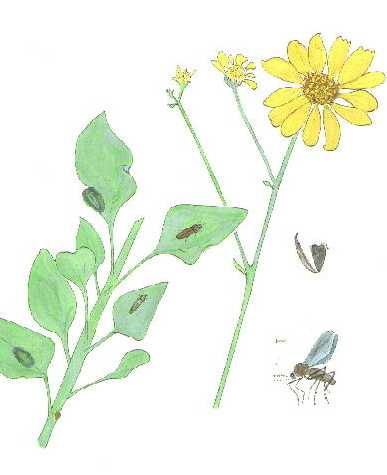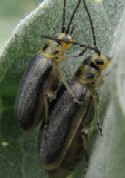Brittle Bush
Gall Midge
Encelia Leaf Beetle
Encelia farinosa
Sponsored Links:

This watercolor was done from a live specimen found in the McDowell Mts., Maricopa Co., Arizona, USA. Feb. 9, 1992.
Sponsored Links:
FLOWERS: Bright yellow and very showy ray flowers. Even meager winter
rainfall will result in a magnificent show of large vivid yellow flowers on
this perennial. The disc flowers are darker yellow, sometimes brownish,
depending on the variety.
SHRUB: The above ground branches frequently die back after prolonged
drought or a severe freeze so that by late February through March the landscape
is dotted with dense green shrubs of nearly uniform height (ca. 1 m) topped by
abundant yellow flowers. No wonder landscapers have discovered the
attractiveness of this native plant.
RANGE: This plant is a characteristic component of the flora throughout
the Sonoran Desert. Brittle Bush grows best where it gets added moisture as
runoff from roads or adjacent impervious rock. Many plants grow back from the
roots after brush fires and often dominate burned slopes for many years hence.
LEAVES: The leaves are covered with varying amounts of long or short
silky trichomes (hairs) that give a silvery appearance. Crushed foliage exudes
a pleasant terpene odor while damaged twigs slowly exude a golden resin that
eventually dries to form glistening globules. This resin has been used as a
substitute for incense, and so the Spanish name Inciensio.
ACHENE: The
achene lacks a
pappus , and is covered by a short pubescence. Each achene is
subtended by a papery bract.
 Several insects have specialized on eating Brittle Bush leaves. A tiny gall
midge (tiny fly, Cecidomyidae) causes fuzzy enlargements on young leaves or
stems where the maggot developes inside. Leaf beetles (Trirhabda geminata)
sometimes become so abundant that every bush seems to be ravaged by the black,
7 mm long larvae. Cool, damp winters sometimes result in exploding aphid
populations, which in turn host numerous lady bird beetles. Lady bird larvae
resemble miniature gila monsters. Each lady bird larva consumes numerous aphids
as it develops. Several species of brightly colored blister beetles
occasionally appear in mass to feed on the tender petals. In addition, the
caterpillars of the
Painted Lady Butterfly can appear in large numbers on this plant.
Several insects have specialized on eating Brittle Bush leaves. A tiny gall
midge (tiny fly, Cecidomyidae) causes fuzzy enlargements on young leaves or
stems where the maggot developes inside. Leaf beetles (Trirhabda geminata)
sometimes become so abundant that every bush seems to be ravaged by the black,
7 mm long larvae. Cool, damp winters sometimes result in exploding aphid
populations, which in turn host numerous lady bird beetles. Lady bird larvae
resemble miniature gila monsters. Each lady bird larva consumes numerous aphids
as it develops. Several species of brightly colored blister beetles
occasionally appear in mass to feed on the tender petals. In addition, the
caterpillars of the
Painted Lady Butterfly can appear in large numbers on this plant.